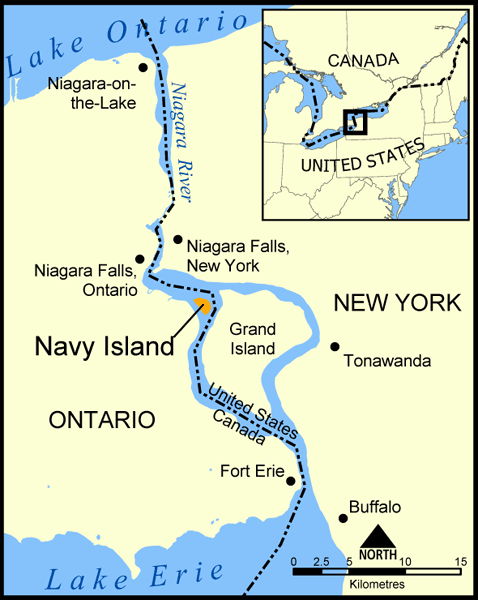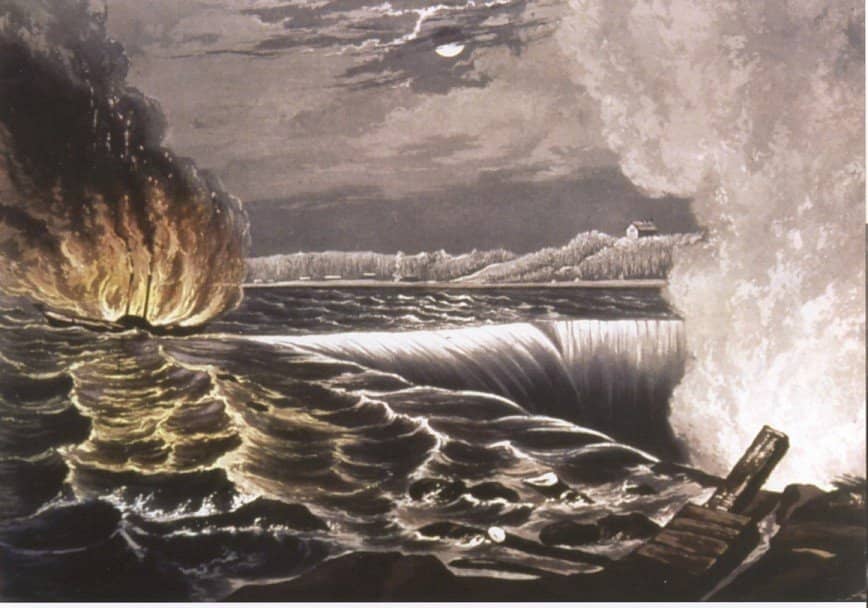HeinOnline’s hometown of Buffalo, NY has a longstanding friendly relationship with our Canadian neighbors across the Niagara River. This is reflected in the name of the bridge connecting our community with Fort Erie, Ontario: the Peace Bridge. There have, however, been some exceptions to this state of affairs in the past. Most notably, during the War of 1812, the Niagara region was the scene of some of the fiercest fighting between American and British and Canadian forces. Less well known is the Caroline affair, an incident that took place 25 years later when a rebellion in Canada and the destruction of an American steamship brought the United States and Great Britain to the brink of another war. Keep reading to learn more about the Caroline affair, and how it transformed American-Canadian relations and international law.
Rebellions in Canada
Between 1837 and 1838, Upper and Lower Canada (areas equivalent to the modern provinces of Ontario and Quebec) were rocked by a series of armed uprisings against the colonial authorities. Their grievances were various, but the majority of rebels shared the goal of replacing the unelected governing Legislative Councils, which were dominated by a small and wealthy circle of oligarchic families, with a more democratic system of governance.
Many of these reforms would be achieved with the passage of the Act of Union of 1840,[1]William Houston. Documents Illustrative of the Canadian Constitution (1891). This document can be found in HeinOnline’s World Constitutions Illustrated. which united Upper and Lower Canada into a single province. But in the short term, the rebellions were suppressed by force, with dozens of rebels deported to the British penal colony in Australia or executed in public hangings. Many other rebels fled to the United States, where they were largely welcomed by American border communities that were sympathetic to what they referred to as the Patriot cause. Buffalo was one such community.
The rebellion in Upper Canada was defeated in December 1837 when rebels, under the command of William Lyon Mackenzie, a reformist politician who had previously served as the first mayor of Toronto, were defeated in their attempt to seize control of the city at the Battle of Montgomery’s Tavern. Those rebels who managed to evade capture fled across the border to the United States. On December 11, Mackenzie and a contingent of his followers arrived in Buffalo, where they were received warmly, with Mackenzie delivering a speech to a sympathetic crowd.

Three days later, Mackenzie and a group of armed rebels launched an invasion of Canada, landing on Navy Island, several miles north of Buffalo on the Canadian side of the border in the Niagara River. There, Mackenzie declared the establishment of an independent Republic of Canada. His followers began stockpiling weapons and preparing to issue their own currency. Mackenzie enticed sympathizers from both sides of the border to join the cause with the promise of land[2]Upper Canada. Report, from the Select Committee of the Legislative Council of Upper Canada, on the State of the Province (1838). This document can be found in HeinOnline’s World Constitutions Illustrated. in the soon-to-be-liberated territory of Canada.

The Caroline Affair
The Republic of Canada was doomed to a short life, but it would prove to have an outsized impact on relations between the United States and Great Britain. On December 29, a force of the Royal Navy and Canadian militia crossed the international border and seized the Caroline, a merchant steamer which they alleged was being used to ferry supplies to the rebels on Navy Island. They set the vessel on fire and, in a dramatic scene, released it adrift in the river for it to tumble, in flames, over Niagara Falls onto the rocks below. Over the course of the exchange of gunfire between the two sides, one bystander on the American shore, Amos Durfree, was killed.
The outrage on the American side of the border was immediate and intense. The Governor of New York, in a speech to the legislature,[3]Upper Canada. Report, from the Select Committee of the Legislative Council of Upper Canada, on the State of the Province (1838). This document can be found in HeinOnline’s World Constitutions Illustrated. declared that “the Territory of this State has been invaded, and some of our citizens murdered, by an armed force from the Province of Upper Canada.” Citizens of Western New York appealed directly to the United States Congress,[4]Memorial of inhabitants of Erie County, New York, on burning of steamboat Caroline by Canadians. H.R. Doc. No. 248, 25th Cong., 2d Sess. (1838). This document can be found in HeinOnline’s U.S. Congressional Serial Set. calling for a military intervention on the border. The incident was also the subject of anxious hearings on the other side of the Atlantic,[5]Destruction of the Caroline. 57 HC Deb 736 (1841). This document can be found in HeinOnline’s UK Parliamentary & Government Publications (Public Information Online) collection. in the British House of Commons.

Neither the American nor British governments had an appetite for war, with the memory of the costly War of 1812 still fresh. Federal troops were dispatched to the border to prevent further escalation from the American side. In early January 1838, British troops and Canadian militia retook Navy Island from the rebels. Matters threatened to escalate again in May when, in retaliation for the burning of the Caroline, a group of 13 Americans seized and burned the British steamer Sir Robert Peel[6]Correspondence on attack on British steamboat Sir Robert Peel and American steamboat Telegraph, in consequence of disturbance in Canada. H.R. Doc. No. 440, 25th Cong., 2d Sess. (1838). This document can be found in HeinOnline’s U.S. … Continue reading near Wellesley Island on the American side of Lake Ontario. However, cooler heads ultimately prevailed. By the end of 1838, the guerilla warfare and cross-border raids now referred to as the Patriot War had been largely suppressed by the concerted action of American and British forces working together.
The final word on the Caroline affair came in 1840 when Alexander McLeod, a Canadian sheriff, was arrested while traveling in New York and tried for the murder of Amos Durfree[7]Trial of Alexander McLeod, for the Murder of Amos Durfee, at the Burning and Destruction of the Steamboat Caroline, by the Canadians, December 29th, 1837 (1841). This document can be found in HeinOnline’s World Trials Library. two years prior. McLeod’s acquittal in an American court, on the basis of insufficient evidence, further reduced tensions along the border. Peace was further cemented along the border in 1842, when representatives of the United States and Great Britain signed the Webster-Ashburton Treaty,[8]Slave trade, boundaries, extradition (Webster-Ashburton Treaty), . 8 Stat. 572 (1778-1845) (1842). This document can be found in HeinOnline’s Session Laws Library. which normalized relations by resolving a number of long-standing disputes, including that of the border between Maine and New Brunswick, which had also come to the brink of bloodshed in the years prior.
Legal Legacy: The Caroline Test
For all of its initial fire and fury, the Caroline affair—as it came to be referred to—fizzled out in the end, and has largely faded from historical memory. However, the legacy of the affair continues to impact international law, in what is now referred to as the Caroline test, or Caroline doctrine. In the study of international law, the Caroline test refers to a legal test for justifiable preemptive self-defense by state actors. The basis of the test was formulated in the aftermath of the burning of the Caroline in a series of letters between United States Secretary of State Daniel Webster and British Foreign Minister Lord Ashburton, as they sought to de-escalate and bring their countries back from the brink of war.
As Webster reasoned,[9]Olivia Gonzalez, The Pen and the Sword: Legal Justifications for the United States’ Engagement against the Islamic State of Iraq and Syria (ISIS), 39 FORDHAM INT’l L.J. 133 (2015). This article can be found in HeinOnline’s Law … Continue reading a state can engage in violent preemptive action, and justify it as self-defense, if there is a need that is “instant, overwhelming, and leaving no choice of means, and no moment of deliberation.” This standard has been applied at various times throughout history as a metric for determining whether or not a state’s preemptive use of military force is justifiable. At the Nuremberg Tribunal, the Caroline test was applied to the claim by defendants that Nazi Germany’s invasion of Norway[10]Noah Weisbord, Judging Aggression, 50 COLUM. J. TRANSNAT’l L. 82 (2011). This article can be found in HeinOnline’s Law Journal Library. was a justifiable act of self-defense. The judges found this line of reasoning unconvincing. In more recent years, the Caroline test has been invoked by officials to justify American military interventions against non-state actors in foreign countries, such as the Obama administration’s campaign against the Islamic State in Iraq and Syria.[11]Gabor Kajtar, The Caroline as the ‘Joker’ of the Law of Self-Defence – A Ghost Ship’s Message for the 21st Century, 21 Austrian Rev. Int’l & Eur. L. 3 (2016). This article can be found in HeinOnline’s Law … Continue reading
Explore Canadian Content in HeinOnline
Did you know that HeinOnline has four databases devoted to our neighbors to the North? (Or, in the case of Buffalo, our neighbors to the West). Check out these resources on Canadian law on HeinOnline, or ask your institution’s librarian to subscribe today:
- Australian & Canadian Acts of the Parliament
- Canada Supreme Court Reports
- Provincial Statutes of Canada
- Revised Statutes of Canada
HeinOnline Sources[+]
| ↑1 | William Houston. Documents Illustrative of the Canadian Constitution (1891). This document can be found in HeinOnline’s World Constitutions Illustrated. |
|---|---|
| ↑2 | Upper Canada. Report, from the Select Committee of the Legislative Council of Upper Canada, on the State of the Province (1838). This document can be found in HeinOnline’s World Constitutions Illustrated. |
| ↑3 | Upper Canada. Report, from the Select Committee of the Legislative Council of Upper Canada, on the State of the Province (1838). This document can be found in HeinOnline’s World Constitutions Illustrated. |
| ↑4 | Memorial of inhabitants of Erie County, New York, on burning of steamboat Caroline by Canadians. H.R. Doc. No. 248, 25th Cong., 2d Sess. (1838). This document can be found in HeinOnline’s U.S. Congressional Serial Set. |
| ↑5 | Destruction of the Caroline. 57 HC Deb 736 (1841). This document can be found in HeinOnline’s UK Parliamentary & Government Publications (Public Information Online) collection. |
| ↑6 | Correspondence on attack on British steamboat Sir Robert Peel and American steamboat Telegraph, in consequence of disturbance in Canada. H.R. Doc. No. 440, 25th Cong., 2d Sess. (1838). This document can be found in HeinOnline’s U.S. Congressional Serial Set. |
| ↑7 | Trial of Alexander McLeod, for the Murder of Amos Durfee, at the Burning and Destruction of the Steamboat Caroline, by the Canadians, December 29th, 1837 (1841). This document can be found in HeinOnline’s World Trials Library. |
| ↑8 | Slave trade, boundaries, extradition (Webster-Ashburton Treaty), . 8 Stat. 572 (1778-1845) (1842). This document can be found in HeinOnline’s Session Laws Library. |
| ↑9 | Olivia Gonzalez, The Pen and the Sword: Legal Justifications for the United States’ Engagement against the Islamic State of Iraq and Syria (ISIS), 39 FORDHAM INT’l L.J. 133 (2015). This article can be found in HeinOnline’s Law Journal Library. |
| ↑10 | Noah Weisbord, Judging Aggression, 50 COLUM. J. TRANSNAT’l L. 82 (2011). This article can be found in HeinOnline’s Law Journal Library. |
| ↑11 | Gabor Kajtar, The Caroline as the ‘Joker’ of the Law of Self-Defence – A Ghost Ship’s Message for the 21st Century, 21 Austrian Rev. Int’l & Eur. L. 3 (2016). This article can be found in HeinOnline’s Law Journal Library. |



